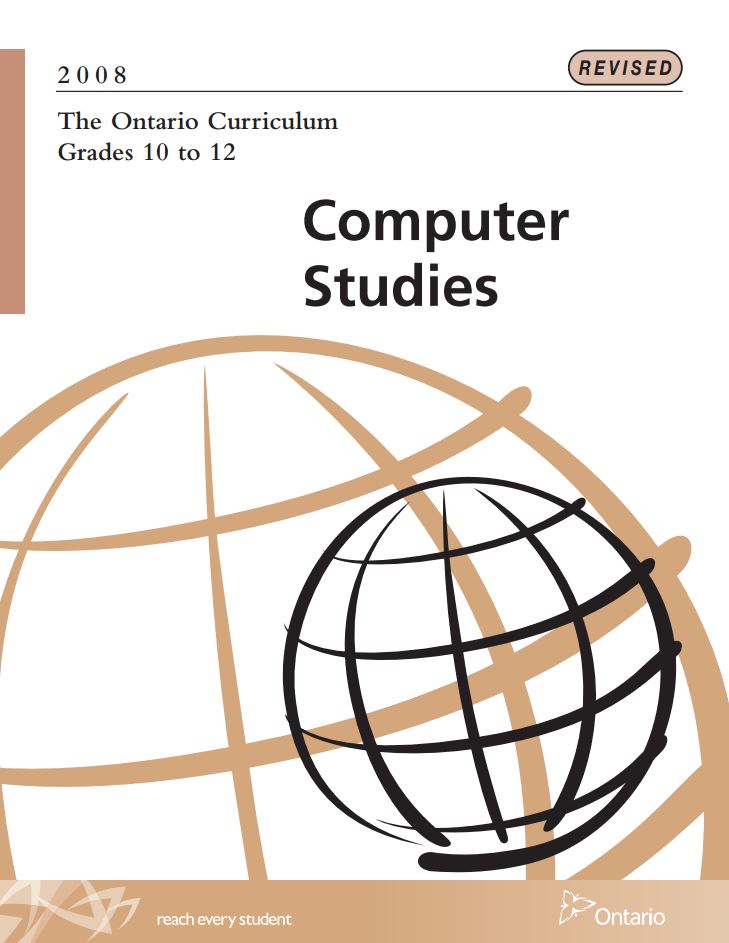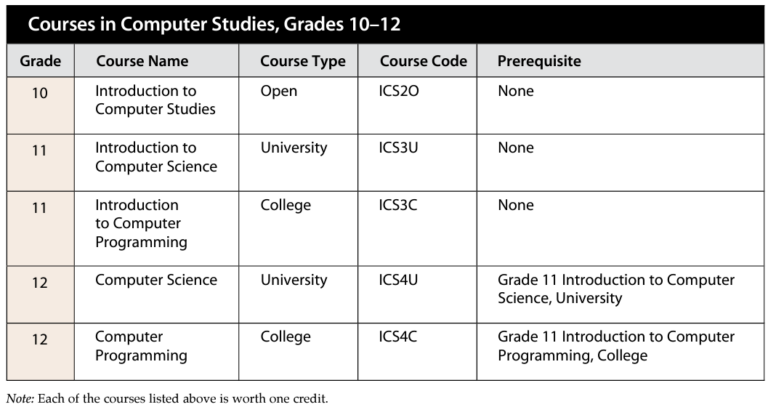Grade 12 Computer Studies
Overview of Grade 12 Computer Studies
STRANDS IN THE COMPUTER STUDIES CURRICULUM
Each of the Grade 11 and 12 Computer Study courses have four strands. In each course, the first strand is “A. Programming Concepts and Skills”, and the second is “B. Software Development”. The third strand (strand C) in each of the courses focuses on the programming environment, and the Grade 12 university preparation course features Designing Modular Programs in this strand. The fourth strand (strand D) deals with the role of computers in society, and includes expectations regarding environmental concerns, the ethical use of computers, and career exploration. In this strand, the university preparation courses also explore new research in the field of information and computer science, and its implications for society.
Computer Science, Grade 12 University Preparation (ICS4U)
This course enables students to further develop knowledge and skills in computer science. Students will use modular design principles to create complex and fully documented programs, according to industry standards. Student teams will manage a large software development project, from planning through to project review. Students will also analyse algorithms for effectiveness. They will investigate ethical issues in computing and further explore environmental issues, emerging technologies, areas of research in computer science, and careers in the field.
Prerequisite: Introduction to Computer Science, Grade 11, University Preparation
Computer Programming, Grade 12 College Preparation (IS44C)
This course further develops students’ computer programming skills. Students will learn object-oriented programming concepts, create object-oriented software solutions, and design graphical user interfaces. Student teams will plan and carry out a software development project using industry-standard programming tools and proper project management techniques. Students will also investigate ethical issues in computing and expand their understanding of environmental issues, emerging technologies, and computer-related careers.
Prerequisite: Introduction to Computer Programming, Grade 11, College Preparation
Ontario Curriculum Breakdown - Grade 12 Computer Science (ICS4U)

SPECIFIC EXPECTATIONS
Data Types and Expressions
By the end of this course, students will:
- A1.1 demonstrate the ability to use integer division and resultant remainders in computer programs;
- A1.2 demonstrate an understanding of type conversion (e.g., string-to-integer, character-to- integer, integer-to-character, floating point-to integer, casting in an inheritance hierarchy);
- A1.3 demonstrate the ability to use non-numeric comparisons (e.g., strings, comparable interface) in computer programs;
- A1.4 demonstrate an understanding of the limitations of finite data representations (e.g., integer bounds, precision of floating-point real numbers, rounding errors) when designing algorithms;
- A1.5 describe and use one-dimensional arrays of compound data types (e.g., objects, structures, records) in a computer program.
Modular Programming
By the end of this course, students will:
- A2.1 create a modular program that is divided among multiple files (e.g., user-defined classes, libraries, modules);
- A2.2 use modular design concepts that support reusable code (e.g., encapsulation, inheritance, method overloading, method overriding, polymorphism);
- A2.3 demonstrate the ability to modify existing modular program code to enhance the functionality of a program.
Designing Algorithms
By the end of this course, students will:
- A3.1 demonstrate the ability to read from, and write to, an external file (e.g., text file, binary file, database, XML file) from within a computer program;
- A3.2 create linear and binary search algorithms to find data in an array; A3.3 create subprograms to insert and delete array elements;
- A3.4 create a sort algorithm (e.g., bubble, insertion, selection) to sort data in an array;
- A3.5 create algorithms to process elements in two dimensional arrays (e.g., multiply each element by a constant, interchange elements, multiply matrices, process pixels in an image);
- A3.6 design a simple and efficient recursive algorithm (e.g., calculate a factorial, translate numbers into words, perform a merge sort, generate fractals, perform XML parsing).
Code Maintenance
By the end of this course, students will:
- A4.1 work independently, using support documentation (e.g., IDE Help, tutorials, websites, user manuals), to resolve syntax issues during software development;
- A4.2 develop and implement a formal testing plan (e.g., unit testing, integration testing, regression testing) for a software project to ensure program correctness;
- A4.3 create fully documented program code according to industry standards (e.g., doc comments, docstrings, block comments, line comments);
- A4.4 create clear and maintainable external user documentation (e.g., Help files, training materials, user manuals).
York Region Tutoring Provides
If a student is approaching a forthcoming test, we can provide them with a previous test to be completed at home before their upcoming session. Subsequently, during their next class, just before the exam, they can review the test with their tutor. These tests are exclusively sourced from high schools in York Region and other areas in Ontario, serving as the definitive benchmark for students to assess their readiness.
York Region Tutors and are equipped with drawing tablets making collaboration simple, efficient and effective. We also offer drawing tablets at a discount for purchase to students who really take to the functionality of the product.
At the parents’ request, following each tutoring session, our tutors can assign homework tailored to address weaknesses and reinforce strengths in students. Additionally, we incorporate homework questions directly extracted from previous tests and quizzes administered by YRDSB school teachers, allowing students to familiarize themselves with potential test questions.

